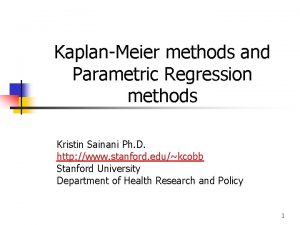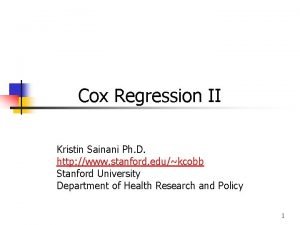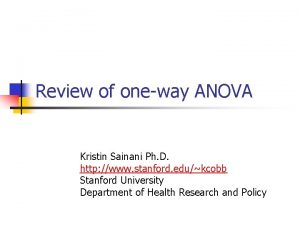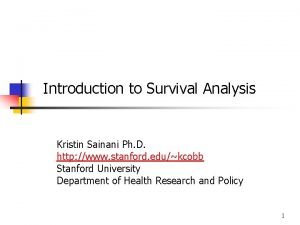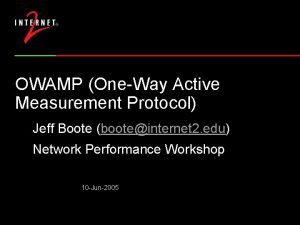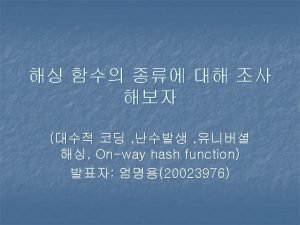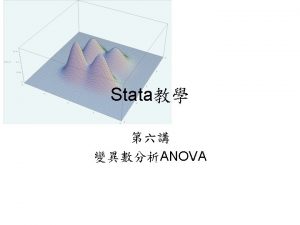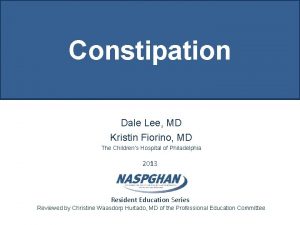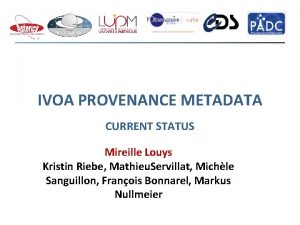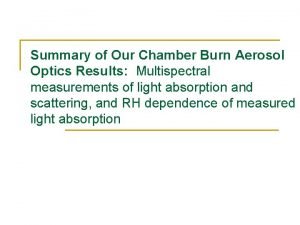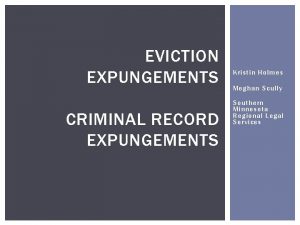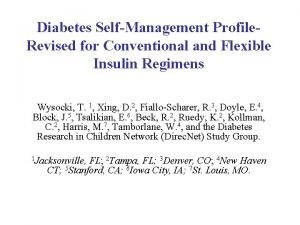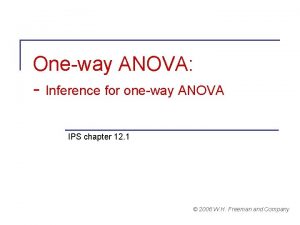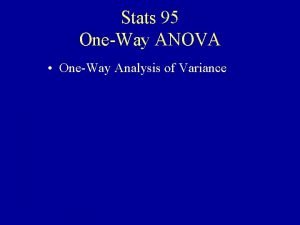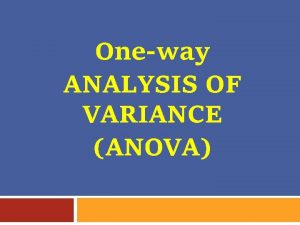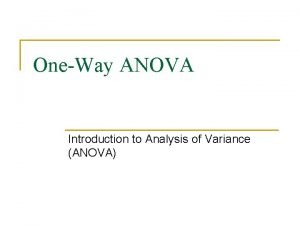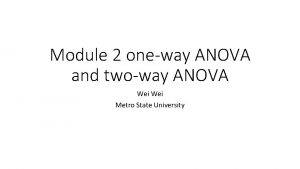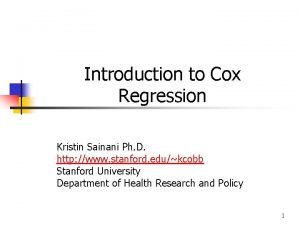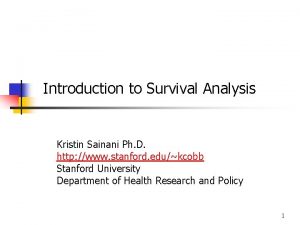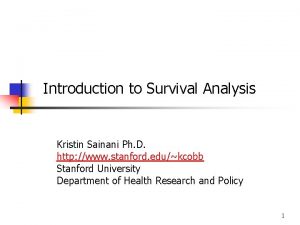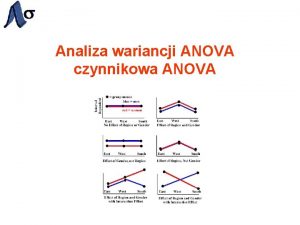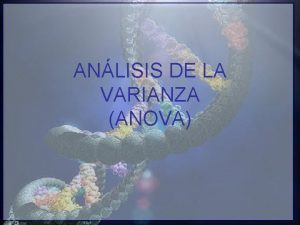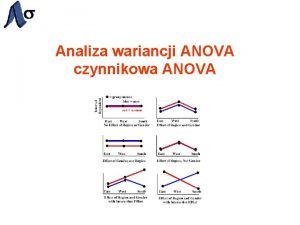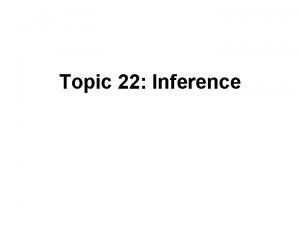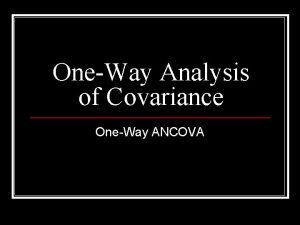Review of oneway ANOVA Kristin Sainani Ph D
























- Slides: 24

Review of one-way ANOVA Kristin Sainani Ph. D. http: //www. stanford. edu/~kcobb Stanford University Department of Health Research and Policy

ANOVA for comparing means between more than 2 groups

The F-distribution n A ratio of variances follows an F-distribution: l. The F-tests the hypothesis that two variances are equal. l. F will be close to 1 if sample variances are equal.

How to calculate ANOVA’s by hand… Treatment 1 Treatment 2 Treatment 3 Treatment 4 y 11 y 21 y 31 y 41 y 12 y 22 y 32 y 42 y 13 y 23 y 33 y 43 y 14 y 24 y 34 y 44 y 15 y 25 y 35 y 45 y 16 y 26 y 36 y 46 y 17 y 27 y 37 y 47 y 18 y 28 y 38 y 48 y 19 y 29 y 39 y 49 y 110 y 210 y 310 y 410 n=10 obs. /group k=4 groups The group means The (within) group variances

Sum of Squares Within (SSW), or Sum of Squares Error (SSE) The (within) group variances + + + Sum of Squares Within (SSW) (or SSE, for chance error)

Sum of Squares Between (SSB), or Sum of Squares Regression (SSR) Overall mean of all 40 observations (“grand mean”) Sum of Squares Between (SSB). Variability of the group means compared to the grand mean (the variability due to the treatment).

Total Sum of Squares (SST) Total sum of squares(TSS). Squared difference of every observation from the overall mean. (numerator of variance of Y!)

Partitioning of Variance + 10 x = SSW + SSB = TSS

ANOVA Table Source of variation d. f. Sum of squares Between (k groups) k-1 SSB Within nk-k F-statistic nk-1 SSW (sum of squared deviations of observations from their group mean) p-value Go to SSB/k-1 (sum of squared deviations of group means from grand mean) (n individuals per group) Total variation Mean Sum of Squares Fk-1, nk-k chart s 2=SSW/nk-k TSS (sum of squared deviations of observations from grand mean) TSS=SSB + SSW

ANOVA=t-test Source of variation Between (2 groups) Within d. f. 1 2 n-2 Sum of squares SSB (squared difference in means multiplied by n) SSW equivalent to numerator of pooled variance Total 2 n-1 variation TSS Mean Sum of Squares Squared difference in means times n Pooled variance F-statistic p-value Go to F 1, 2 n-2 Chart notice values are just (t 2 n 2 2)

Example Treatment 1 Treatment 2 Treatment 3 Treatment 4 60 inches 50 48 47 67 52 49 67 42 43 50 54 67 67 55 67 56 68 62 59 61 65 64 67 61 65 59 64 60 56 72 63 59 60 71 65 64 65

Example Step 1) calculate the sum of squares between groups: Treatment 1 Treatment 2 Treatment 3 Treatment 4 60 inches 50 48 47 67 52 49 67 42 43 50 54 67 67 55 67 Mean for group 2 = 59. 7 56 68 62 59 61 65 Mean for group 3 = 56. 3 64 67 61 65 59 64 60 56 72 63 59 60 71 65 64 65 Mean for group 1 = 62. 0 Mean for group 4 = 61. 4 Grand mean= 59. 85 SSB = [(62 -59. 85)2 + (59. 7 -59. 85)2 + (56. 3 -59. 85)2 + (61. 4 -59. 85)2 ] xn per group= 19. 65 x 10 = 196. 5

Example Step 2) calculate the sum of squares within groups: (60 -62) 2+(67 -62) 2+ (42 -62) 2+ (67 -62) 2+ (56 -62) 2+ (6262) 2+ (64 -62) 2+ (59 -62) 2+ (72 -62) 2+ (71 -62) 2+ (5059. 7) 2+ (52 -59. 7) 2+ (4359. 7) 2+67 -59. 7) 2+ (6759. 7) 2+ (69 -59. 7) 2…+…. (sum of 40 squared deviations) = 2060. 6 Treatment 1 Treatment 2 Treatment 3 Treatment 4 60 inches 50 48 47 67 52 49 67 42 43 50 54 67 67 55 67 56 68 62 59 61 65 64 67 61 65 59 64 60 56 72 63 59 60 71 65 64 65

Step 3) Fill in the ANOVA table Source of variation d. f. Sum of squares Mean Sum of Squares F-statistic p-value Between 3 196. 5 65. 5 1. 14 . 344 Within 36 2060. 6 57. 2 Total 39 2257. 1

Step 3) Fill in the ANOVA table Source of variation d. f. Sum of squares Mean Sum of Squares F-statistic p-value Between 3 196. 5 65. 5 1. 14 . 344 Within 36 2060. 6 57. 2 Total 39 2257. 1 INTERPRETATION of ANOVA: How much of the variance in height is explained by treatment group? R 2=“Coefficient of Determination” = SSB/TSS = 196. 5/2275. 1=9%

Coefficient of Determination The amount of variation in the outcome variable (dependent variable) that is explained by the predictor (independent variable).

ANOVA example Table 6. Mean micronutrient intake from the school lunch by school Calcium (mg) Iron (mg) Folate (μg) Zinc (mg) Mean SDe Mean SD S 1 a, n=25 117. 8 62. 4 2. 0 0. 6 26. 6 13. 1 1. 9 1. 0 S 2 b, n=25 158. 7 70. 5 2. 0 0. 6 38. 7 14. 5 1. 2 S 3 c, n=25 206. 5 86. 2 2. 0 0. 6 42. 6 15. 1 1. 3 0. 4 School 1 (most deprived; 40% subsidized lunches). b School 2 (medium deprived; <10% subsidized). c School 3 (least deprived; no subsidization, private school). d ANOVA; significant differences are highlighted in bold (P<0. 05). a P-valued 0. 000 0. 854 0. 000 0. 055

Answer Step 1) calculate the sum of squares between groups: Mean for School 1 = 117. 8 Mean for School 2 = 158. 7 Mean for School 3 = 206. 5 Grand mean: 161 SSB = [(117. 8 -161)2 + (158. 7 -161)2 + (206. 5 -161)2] x 25 per group= 98, 113

Answer Step 2) calculate the sum of squares within groups: S. D. for S 1 = 62. 4 S. D. for S 2 = 70. 5 S. D. for S 3 = 86. 2 Therefore, sum of squares within is: (24)[ 62. 42 + 70. 5 2+ 86. 22]=391, 066

Answer Step 3) Fill in your ANOVA table Source of variation d. f. Sum of squares Between 2 98, 113 Mean Sum of Squares 49056 Within 72 391, 066 5431 Total 74 489, 179 F-statistic p-value 9 <. 05 **R 2=98113/489179=20% School explains 20% of the variance in lunchtime calcium intake in these kids.

Beyond one-way ANOVA Often, you may want to test more than 1 treatment. ANOVA can accommodate more than 1 treatment or factor, so long as they are independent. Again, the variation partitions beautifully! TSS = SSB 1 + SSB 2 + SSW

The Regression Picture yi C A B y B A C *Least squares estimation gave us the line (β) that minimized C 2 yi x A 2 =SSy A 2 B 2 SS total Total squared distance of observations from naïve mean of y SS Total variation reg Distance from regression line to naïve mean of y Variability due to x (regression) C 2 SS R 2=SSreg/SStotal residual Variance around the regression line Additional variability not explained by x—what least squares method aims to minimize

Standard error of y/x Sy/x 2= average residual squared (what we’ve tried to minimize) (equivalent to MSE(=SSW/df) in ANOVA)

The standard error of Y given X is the average variability around the regression line at any given value of X. It is assumed to be equal at all values of X. Sy/x Y Sy/x X
 Hazard ratio formula
Hazard ratio formula Kristin sainani
Kristin sainani Kristin sainani
Kristin sainani Kristin sainani
Kristin sainani Jeff boote
Jeff boote Haval algorithm
Haval algorithm Stata oneway
Stata oneway Contoh one way anova dan two way anova
Contoh one way anova dan two way anova Perbedaan one way anova dan two way anova
Perbedaan one way anova dan two way anova One way anova vs two way anova
One way anova vs two way anova Kristin fiorino
Kristin fiorino Kristin riebe
Kristin riebe Kristin lewis unr
Kristin lewis unr Kristin hamann
Kristin hamann Kristin holmes
Kristin holmes Kristin v stephens-martinez
Kristin v stephens-martinez Kristin bentz
Kristin bentz Kristin brodie
Kristin brodie Dsmp kristin
Dsmp kristin Kristin isaksen
Kristin isaksen Temporary keratoprosthesis cpt code
Temporary keratoprosthesis cpt code Kristin kiesel
Kristin kiesel Lions of little rock by kristin levine
Lions of little rock by kristin levine Kristin stephens-martinez
Kristin stephens-martinez Adhb hippo
Adhb hippo
